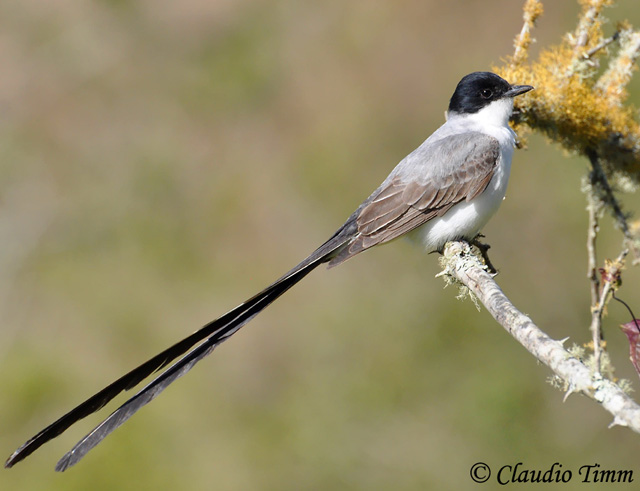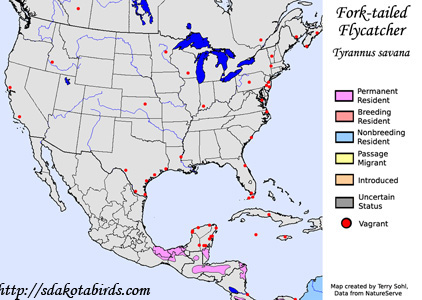| Length: 10 to 16 inches (dependent on tail length) | Wingspan: 15 inches | Seasonality: Non-resident in South Dakota |
| ID Keys: Extremely long tail, males with significantly longer tail, black head and white throat, gray upperparts, white underparts | ||
 The
Fork-tailed Flycatcher competes with North America's Scissor-tailed
Flycatcher for the bird with the longest tail on the continent.
However, while the Scissor-tailed Flycatcher has a native range over parts
of the United States, the Fork-tailed Flycatcher is just a vagrant to the
United States. They are normally found from southern Mexico, through Central
America, and into much of South America. While many sightings of the
species have occurred near the Atlantic coast of the United States, they
have been found from coast-to-coast in scattered locations, and have even
been found as far north as southern Canada. Given that Mexican and
Central American populations are largely permanent residents, it is thought
that birds found in the United States and Canada are from migratory
populations in South America.
The
Fork-tailed Flycatcher competes with North America's Scissor-tailed
Flycatcher for the bird with the longest tail on the continent.
However, while the Scissor-tailed Flycatcher has a native range over parts
of the United States, the Fork-tailed Flycatcher is just a vagrant to the
United States. They are normally found from southern Mexico, through Central
America, and into much of South America. While many sightings of the
species have occurred near the Atlantic coast of the United States, they
have been found from coast-to-coast in scattered locations, and have even
been found as far north as southern Canada. Given that Mexican and
Central American populations are largely permanent residents, it is thought
that birds found in the United States and Canada are from migratory
populations in South America.
Habitat: Found in open habitats, including shrublands, savannahs with scattered shrubs and trees, and agricultural land.
Diet: Feeds on insects. They will also occasionally feed on small fruits and berries.
Behavior: Most often forages by observing from a perch, and flying out to capture insects that it spots. Will also perch while feeding on fruits and berries.
Nesting: The nest of a Fork-tailed Flycatcher is an open cup built of twigs, grasses and weed stems. The female usually lays between 2 and 4 eggs, and she alone incubates the eggs.
Song: In North America, they aren't often heard. The most common call is a series of high, sharp twittering and chip notes.
Migration: Considered a permanent resident in part of their normal range, but other populations are migratory. Given the number of sightings in the United States, the species is obviously prone to wander on occasion away from its normal range.
Interactive eBird Map: Click here to access an interactive eBird map of Fork-tailed Flycatcher sightings
Similar Species: Given the length of the tail, when the species is seen in the United States, it is most likely to be confused with the Scissor-tailed Flycatcher. The two species do have rather different plumages, however.
Conservation Status: Populations are large, spread over a wide geographic area, and they are relatively common in parts of their range. The IUCN lists the Fork-tailed Flycatcher as a species of "Least Concern".
Further Information: 1) BirdLilfe International - Fork-tailed Flycatcher
2) Cornell's NeoTropical Birds - Fork-tailed Flycatcher
3) USGS Patuxent - Fork-tailed Flycatcher
Photo Information: Photo taken by Claudio Timm - November 2nd, 2010 - Rio Grande du Sol, Brazil - Photo licensed under Creative Commons Attribution NonCommercial ShareAlike 2.0 Generic License.
| Click below for a higher-resolution map |
 |
| South Dakota Status: Non-resident in South Dakota |
Additional Fork-tailed Flycatcher Photos (coming soon!!)
